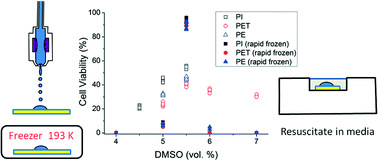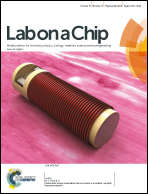High throughput cryopreservation of cells by rapid freezing of sub-μl drops using inkjet printing – cryoprinting
Abstract
We have successfully used inkjet printing to cryopreserve 3T3 mouse fibroblast cells and human neuroprogenitor cells (NPCs) derived from human embryonic stem cells (hESCs). Sessile drops of volume 114 nl were formed by printing cell suspensions containing dimethyl sulphoxide (DMSO) as a cryoprotection agent (CPA) at rates in the region 100 Hz–20 kHz, from individual droplets of 380 pl. After printing and a freeze/thaw cycle (with a minimum 24 hours hold period at liquid N2 temperature), 3T3 cells showed an average viability of >90% with CPA concentration <0.8 M at all drop deposition rates. This is a significantly lower CPA concentration than normally used with conventional cryopreservation methods. Cell viability shows a small variation with the polymer substrates used, with the best results obtained using a polyimide substrate. The viability of 3T3 cells after 2 months storage at liquid nitrogen temperature was slightly reduced compared to the cells held for 24 hours but there was no significant further deterioration after 4 or 6 months storage. The viability of NPCs after an identical freeze/thaw cycle were only 55% but this is comparable with conventional cryopreservation methods that use much higher CPA concentrations. A parallel series of experiments printing cells onto substrates held at 195 K or directly into liquid N2 showed considerable variation in cell survival rate with drop deposition rate. Cell suspensions required higher levels of CPA than when printing followed by freezing. At low deposition rates a combination of DMSO and polyethylene glycol (PEG) was needed to allow cell viability after freezing. These results show that inkjet printing provides a practical high throughput method for the cryopreservation of cells with lower CPA concentrations than are required for current low volume cryopreservation methods.


 Please wait while we load your content...
Please wait while we load your content...